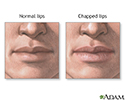Chapped lips
Lips - chapped and dry
Information
Here are some recommendations for preventing chapped lips:
- Avoid excessive sun exposure.
- Avoid going out in dry, cold weather without putting on lip balm or lipstick.
- Try to keep the air in your home humid.
- Use a sunscreen on your lips when outside in sunny weather.
Here are some recommendations for soothing chapped and sore lips:
- Drink additional fluids in winter months.
-
Treat chapped lips with
beeswax
and petrolatum (Vaseline).
Beeswax
Beeswax is wax from the honeycomb of bees. Beeswax poisoning occurs when someone swallows beeswax. This article is for information only. DO NOT use...
Read Article Now Book Mark Article
See your health care provider if you have sores that will not heal on your lips.
References
Habif TP. Atopic dermatitis. In: Habif TP, ed. Clinical Dermatology . 6th ed. Philadelphia, PA: Elsevier; 2016:chap 5.
Habif TP. Warts, herpes simplex, and other viral infections. In: Habif TP, ed. Clinical Dermatology . 6th ed. Philadelphia, PA: Elsevier; 2016:chap 12.
James WD, Berger TG, Elston DM. Cutaneous signs and diagnosis. In: James WD, Berger TG, Elston DM, eds. Andrews' Diseases of the Skin: Clinical Dermatology . 12th ed. Philadelphia, PA: Elsevier; 2016:chap 2.
-
Chapped lips - illustration
Dry chapped lips can occur in cold and even warm weather. To avoid chapped lips, use a lip balm with sunscreen when outside in any weather. To soothe dry chapped lips treat with beeswax and phenol (such as Carmex).
Chapped lips
illustration
Review Date: 12/10/2016
Reviewed By: Linda J. Vorvick, MD, Clinical Associate Professor, Department of Family Medicine, UW Medicine, School of Medicine, University of Washington, Seattle, WA. Also reviewed by David Zieve, MD, MHA, Medical Director, Brenda Conaway, Editorial Director, and the A.D.A.M. Editorial team.

